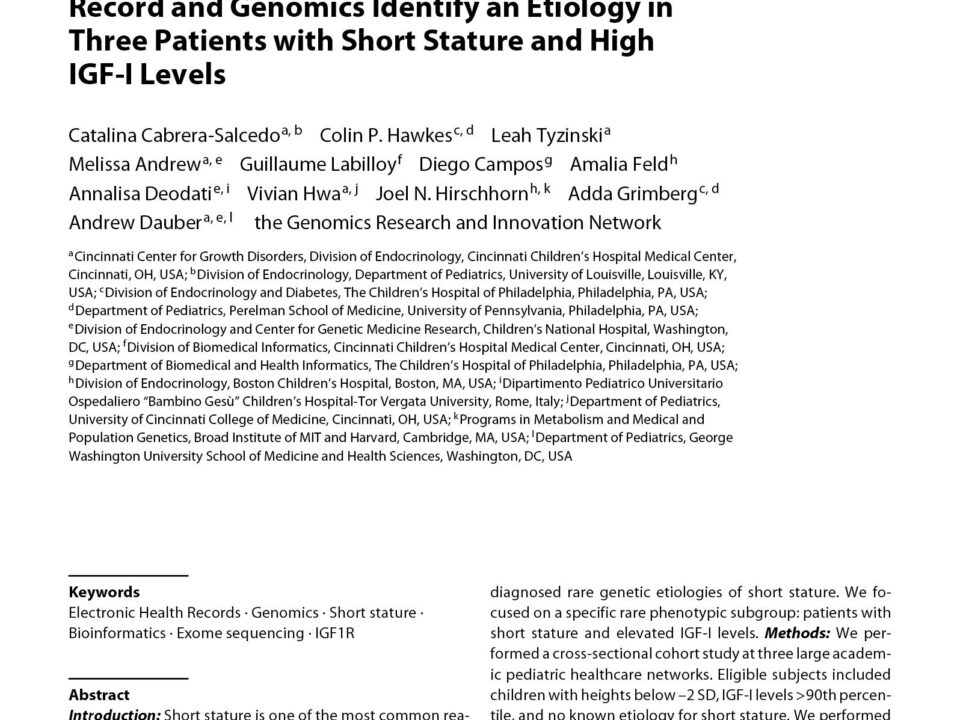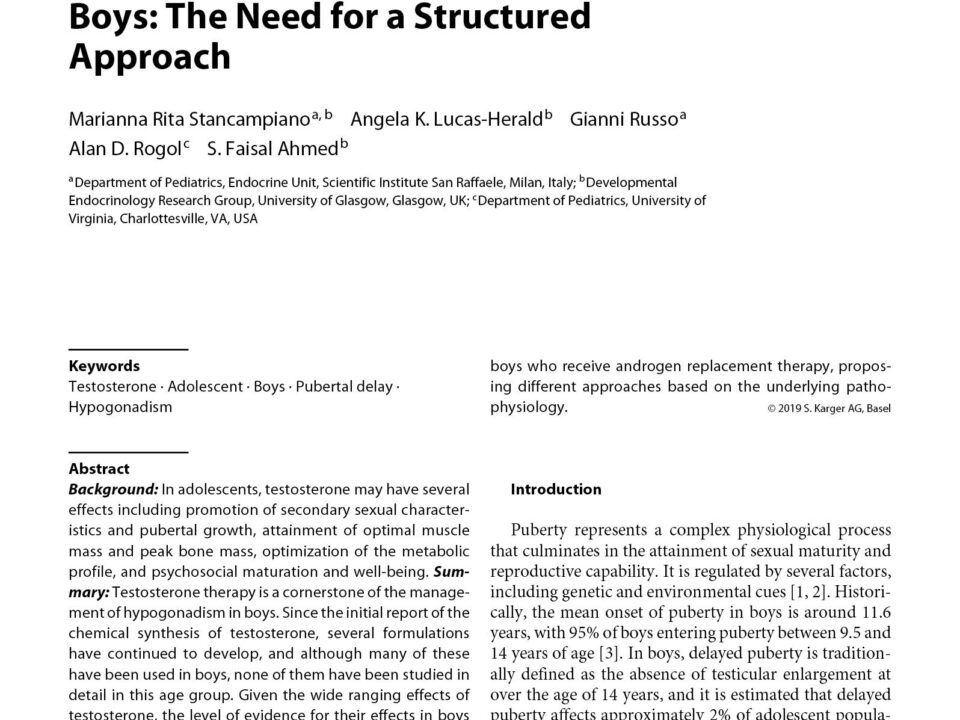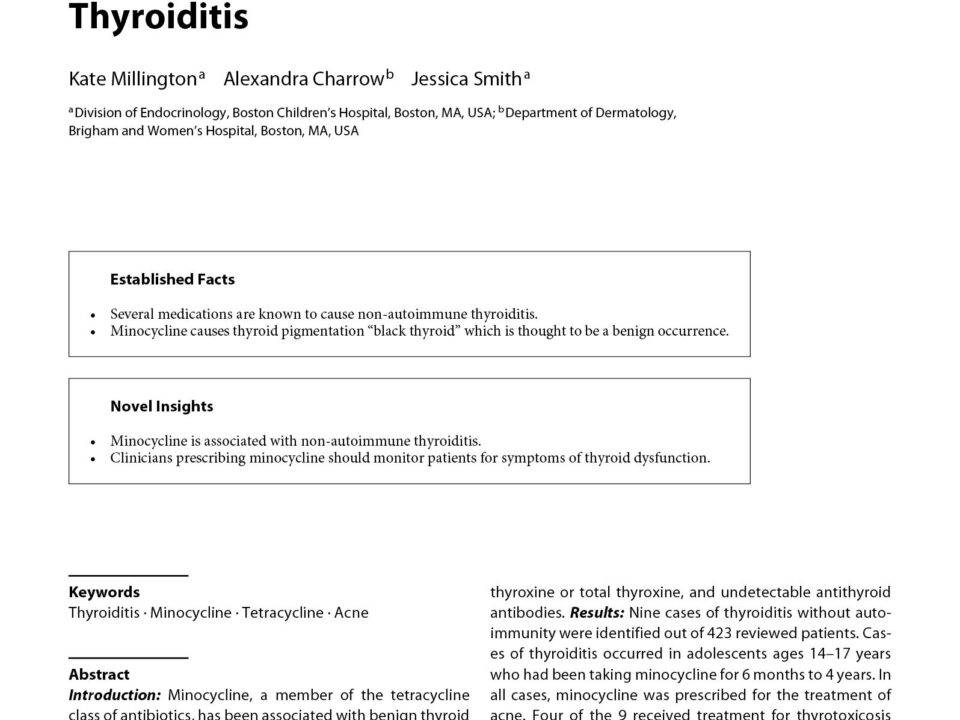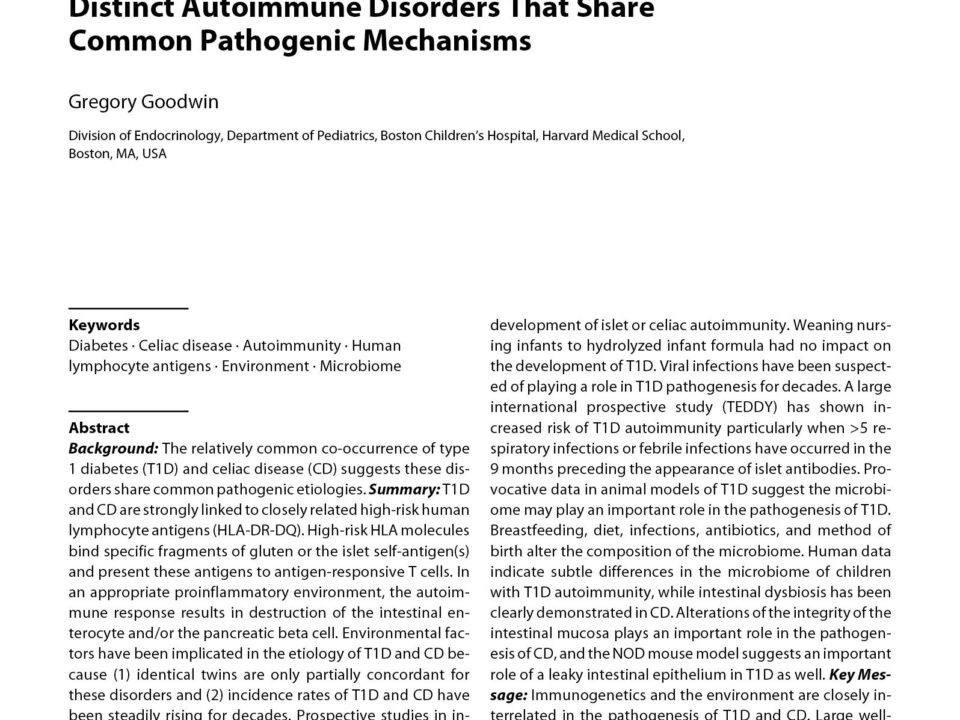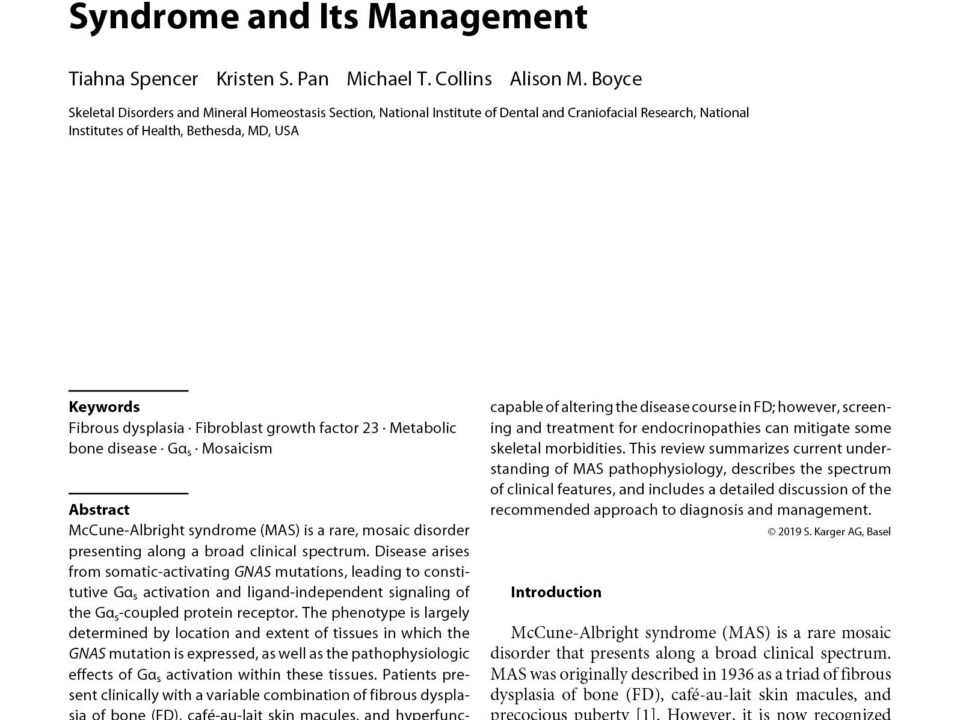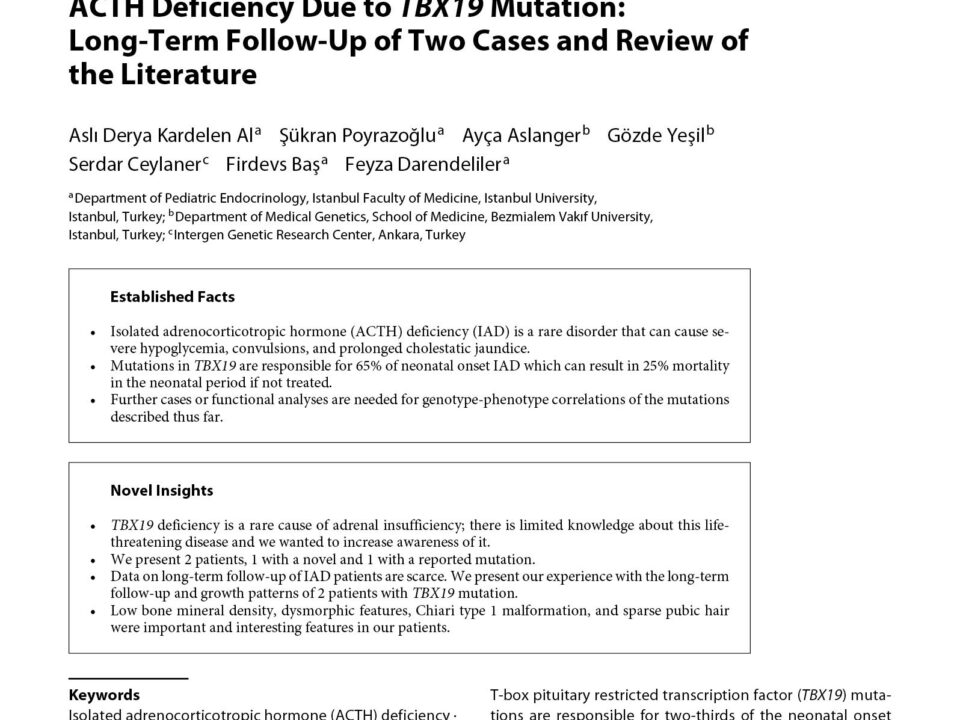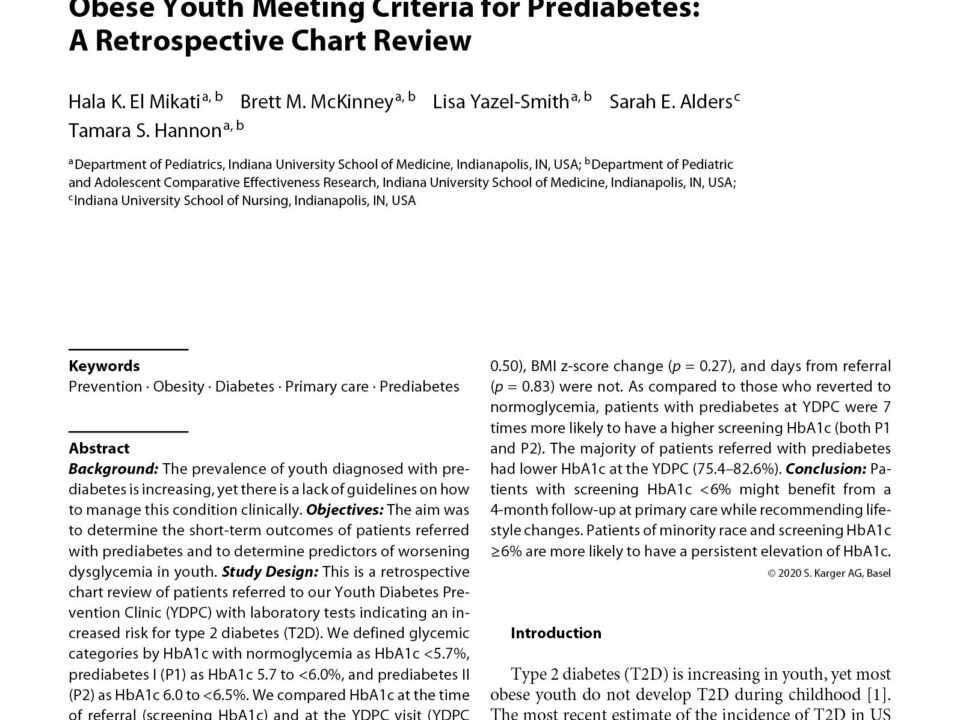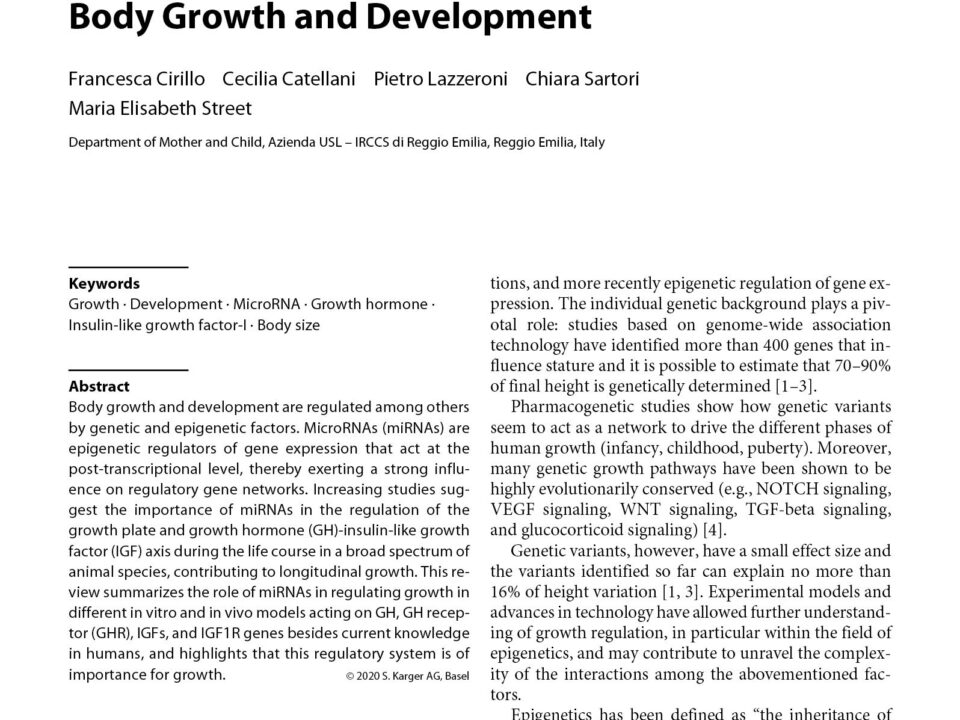December 13, 2022
Introduction: Short stature is one of the most common reasons for referral to a pediatric endocrinologist and can result from many etiologies. However, many patients with short stature do not receive a definitive diagnosis. Objective: To ascertain whether integrating targeted bioinformatics searches of electronic health records (EHRs) combined with genomic studies could identify patients with previously undiagnosed rare genetic etiologies of short stature. We focused on a specific rare phenotypic subgroup: patients with short stature and elevated IGF-I levels. Methods: We performed a cross-sectional cohort study at three large academic pediatric healthcare networks. Eligible subjects included children with heights below –2 SD, IGF-I levels >90th percentile, and no known etiology for short stature. We performed a search of the EHRs to identify eligible patients. Patients were then recruited for phenotyping followed by exome sequencing and in vitro assays of IGF1R function. Results: A total of 234 patients were identified by the bioinformatics algorithm with 39 deemed eligible after manual review (17%). Of those, 9 were successfully recruited. A genetic etiology was identified in 3 of the 9 patients including 2 novel variants in IGF1R and a de novo variant in CHD2. In vitro studies supported the pathogenicity of the IGF1R variants. Conclusions: This study provides proof of principle that patients with rare phenotypic subgroups can be identified based on discrete data elements in the EHRs. Although limitations exist to fully automating this approach, these searches may help find patients with previously unidentified rare genetic disorders.
December 13, 2022
Background: In adolescents, testosterone may have several effects including promotion of secondary sexual characteristics and pubertal growth, attainment of optimal muscle mass and peak bone mass, optimization of the metabolic profile, and psychosocial maturation and well-being. Summary: Testosterone therapy is a cornerstone of the management of hypogonadism in boys. Since the initial report of the chemical synthesis of testosterone, several formulations have continued to develop, and although many of these have been used in boys, none of them have been studied in detail in this age group. Given the wide ranging effects of testosterone, the level of evidence for their effects in boys and the heterogeneity of conditions that lead to early-onset hypogonadism, a standardized protocol for monitoring testosterone replacement in this age group is needed. Key Messages: In this review, we focus on the perceived benefits of androgen replacement in boys affected by pubertal delay and highlight the need to improve the health monitoring of boys who receive androgen replacement therapy, proposing different approaches based on the underlying pathophysiology.
December 13, 2022
Introduction: Minocycline, a member of the tetracycline class of antibiotics, has been associated with benign thyroid pigmentation but reports of thyroid dysfunction are sparse. Methods: Cases were selected via an inquiry of the electronic medical records for patients with thyroid dysfunction and the use of a tetracycline antibiotic. Non-autoimmune thyroiditis was defined as abnormally low or suppressed thyroid-stimulating hormone (TSH, <0.3 µIU/mL), elevated free thyroxine or total thyroxine, and undetectable antithyroid antibodies. Results: Nine cases of thyroiditis without autoimmunity were identified out of 423 reviewed patients. Cases of thyroiditis occurred in adolescents ages 14–17 years who had been taking minocycline for 6 months to 4 years. In all cases, minocycline was prescribed for the treatment of acne. Four of the 9 received treatment for thyrotoxicosis with a β-blocker (in 3 cases) and/or antithyroid drug (in 2 cases). Thyroiditis was symptomatic in all but one individual who presented with painless goiter. All thyroiditis was transient and resolved after a median of 4.5 months (range 2–5 months). In one case, thyroiditis was followed by transient hypothyroidism. Discussion: Minocycline is known to cause thyroid abnormalities, although it has not been definitively linked to thyroid dysfunction. Here, we report 9 cases of non-autoimmune thyroiditis in adolescents receiving minocycline for acne. We recommend that minocycline exposure be considered in the differential diagnosis for thyroiditis and that patients receiving minocycline be counseled regarding the risk of thyroid dysfunction.
December 13, 2022
Background: The relatively common co-occurrence of type 1 diabetes (T1D) and celiac disease (CD) suggests these disorders share common pathogenic etiologies. Summary: T1D and CD are strongly linked to closely related high-risk human lymphocyte antigens (HLA-DR-DQ). High-risk HLA molecules bind specific fragments of gluten or the islet self-antigen(s) and present these antigens to antigen-responsive T cells. In an appropriate proinflammatory environment, the autoimmune response results in destruction of the intestinal enterocyte and/or the pancreatic beta cell. Environmental factors have been implicated in the etiology of T1D and CD because (1) identical twins are only partially concordant for these disorders and (2) incidence rates of T1D and CD have been steadily rising for decades. Prospective studies in infants genetically predisposed to T1D and CD showed that antibody positivity to both disorders begins in the first 1–3 years of life. Viral infections and early exposure to gluten or cow’s milk in the infant diet have been implicated in disease pathogenesis. However, delaying introduction of gluten in the infant diet until 12 months of age had no impact on the development of islet or celiac autoimmunity. Weaning nursing infants to hydrolyzed infant formula had no impact on the development of T1D. Viral infections have been suspected of playing a role in T1D pathogenesis for decades. A large international prospective study (TEDDY) has shown increased risk of T1D autoimmunity particularly when >5 respiratory infections or febrile infections have occurred in the 9 months preceding the appearance of islet antibodies. Provocative data in animal models of T1D suggest the microbiome may play an important role in the pathogenesis of T1D. Breastfeeding, diet, infections, antibiotics, and method of birth alter the composition of the microbiome. Human data indicate subtle differences in the microbiome of children with T1D autoimmunity, while intestinal dysbiosis has been clearly demonstrated in CD. Alterations of the integrity of the intestinal mucosa plays an important role in the pathogenesis of CD, and the NOD mouse model suggests an important role of a leaky intestinal epithelium in T1D as well. Key Message: Immunogenetics and the environment are closely interrelated in the pathogenesis of T1D and CD. Large well-designed prospective studies in at-risk populations informed by scientifically rigorous studies in animal models are likely to have the greatest impact on our understanding of the complex pathogenesis of these detrimental autoimmune disorders.
December 13, 2022
Introduction: Although growth hormone (GH) is essential for attainment of peak bone mass, bone health in prepubertal children with GH deficiency is not routinely evaluated. The objective of this study was to evaluate bone microarchitecture in GH-deficient (GHD) boys using high-resolution peripheral quantitative computed tomography (HR-pQCT). Methods: Fifteen control and fifteen GHD, GH naïve pre-pubertal boys were recruited for a case-control study at a major academic center. Subjects with panhypopituitarism, chromosomal pathology, chronic steroids, or stimulant use were excluded. Volumetric bone mineral density (vBMD; total, cortical, and trabecular), bone geometry (total, cortical and trabecular cross-sectional area, cortical perimeter), bone microarchitecture, and estimated bone strength of the distal radius and tibia were assessed by HR-pQCT. Areal BMD and body composition were assessed by DXA. Insulin-like growth factor 1 (IGF-1), osteocalcin, C telopeptide, and P1NP levels were measured. Results: GHD subjects had a significantly smaller cortical perimeter of the distal radius compared to controls (p < 0.001), with the difference in cortical perimeter persisting after adjusting for height z score, age, lean mass, and 25-hydroxyvitamin D level (p < 0.05).No significant differences were found in vBMD. No significant differences were found in microarchitecture, estimated strength, areal BMD, body composition, or bone turnover markers. Analysis showed significant positive correlations between IGF-1 levels and cortical parameters. Discussion/Conclusions: Prepubertal GHD boys had deficits in bone geometry not evident with DXA. Larger prospective/longitudinal HR-pQCT studies are needed to determine the extent of these deficits, the need for routine bone evaluation, and the timing of GH replacement for prevention or restoration of these deficits.
December 13, 2022
McCune-Albright syndrome (MAS) is a rare, mosaic disorder presenting along a broad clinical spectrum. Disease arises from somatic-activating GNAS mutations, leading to constitutive Gαs activation and ligand-independent signaling of the Gαs-coupled protein receptor. The phenotype is largely determined by location and extent of tissues in which the GNAS mutation is expressed, as well as the pathophysiologic effects of Gαs activation within these tissues. Patients present clinically with a variable combination of fibrous dysplasia of bone (FD), café-au-lait skin macules, and hyperfunctioning endocrinopathies. In bone, Gαs leads to impaired differentiation of skeletal stem cells and formation of discrete, expansile FD lesions, resulting in fractures, pain, and functional impairment. A systematic approach to diagnosis and management is critically important to optimize outcomes for patients with FD/MAS. There are no medical therapies capable of altering the disease course in FD; however, screening and treatment for endocrinopathies can mitigate some skeletal morbidities. This review summarizes current understanding of MAS pathophysiology, describes the spectrum of clinical features, and includes a detailed discussion of the recommended approach to diagnosis and management.
December 13, 2022
Introduction: Isolated adrenocorticotropic hormone (ACTH) deficiency (IAD) is a rare cause of adrenal insufficiency and T-box pituitary restricted transcription factor (TBX19) mutations are responsible for two-thirds of the neonatal onset form of the disease. IAD presents with hypoglycemia and prolonged jaundice in the neonatal period. TBX19 is important for both pro-opiomelanocortin (POMC) gene transcription and differentiation of POMC-expressing cells. We describe 2 patients, 1 with a reported and 1 with a novel TBX19 mutation, and present information about the long-term follow-up of these patients. Case Presentation: Both patients had critical illnesses, recurrent hypoglycemia, convulsions, and neonatal hyperbilirubinemia. They also had low cortisol and ACTH levels, while other pituitary hormones were within the normal range. Pituitary imaging was normal. After hydrocortisone treatment, there was resolution of the hypoglycemia and the convulsions were controlled. Genetic studies of the patients revealed both had inherited a homozygous mutation of the TBX19 gene. The first patient had an alteration of NM_005149.3:c.856C>T (p.R286*) and the second patient had a novel NM_005149.3:c.584C>T (p.T195I) mutation, analyzed by next-generation sequencing. The noteworthy findings of the patients at follow-up were: short stature, microcephaly, and decreased pubic hair in the first, and dysmorphic features, Chiari type 1 malformation, tall stature, and low bone mineral density (BMD) in the second. Conclusion: Congenital IAD can be life-threatening if it is not recognized and treated early. TBX19 mutations should be considered in the differential diagnosis of IAD. Further cases or functional analyses are needed for genotype-phenotype correlations. Low BMD, dysmorphic features, Chiari type 1 malformation, and sparse pubic hair are some of the important features in these patients.
December 13, 2022
Background: The prevalence of youth diagnosed with prediabetes is increasing, yet there is a lack of guidelines on how to manage this condition clinically. Objectives: The aim was to determine the short-term outcomes of patients referred with prediabetes and to determine predictors of worsening dysglycemia in youth. Study Design: This is a retrospective chart review of patients referred to our Youth Diabetes Prevention Clinic (YDPC) with laboratory tests indicating an increased risk for type 2 diabetes (T2D). We defined glycemic categories by HbA1c with normoglycemia as HbA1c <5.7%, prediabetes I (P1) as HbA1c 5.7 to <6.0%, and prediabetes II (P2) as HbA1c 6.0 to <6.5%. We compared HbA1c at the time of referral (screening HbA1c) and at the YDPC visit (YDPC HbA1c) to assess for improvement or worsening. Multinomial logistic regression was used to assess predictors of prediabetes. Results: Among 562 patients seen, 336 had both screening and YDPC HbA1c values. Race (p < 0.001) and screening glycemic category (p < 0.001) were significantly associated with dysglycemia at the YDPC visit, while sex (p = 0.50), BMI z-score change (p = 0.27), and days from referral (p = 0.83) were not. As compared to those who reverted to normoglycemia, patients with prediabetes at YDPC were 7 times more likely to have a higher screening HbA1c (both P1 and P2). The majority of patients referred with prediabetes had lower HbA1c at the YDPC (75.4–82.6%). Conclusion: Patients with screening HbA1c <6% might benefit from a 4-month follow-up at primary care while recommending lifestyle changes. Patients of minority race and screening HbA1c ≥6% are more likely to have a persistent elevation of HbA1c.
December 13, 2022
Body growth and development are regulated among others by genetic and epigenetic factors. MicroRNAs (miRNAs) are epigenetic regulators of gene expression that act at the post-transcriptional level, thereby exerting a strong influence on regulatory gene networks. Increasing studies suggest the importance of miRNAs in the regulation of the growth plate and growth hormone (GH)-insulin-like growth factor (IGF) axis during the life course in a broad spectrum of animal species, contributing to longitudinal growth. This review summarizes the role of miRNAs in regulating growth in different in vitro and in vivo models acting on GH, GH receptor (GHR), IGFs, and IGF1R genes besides current knowledge in humans, and highlights that this regulatory system is of importance for growth.
